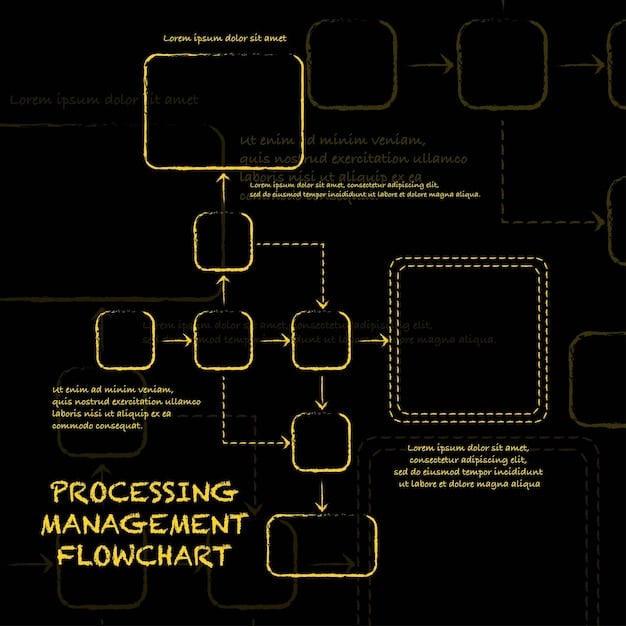US data privacy laws 2025: 7 steps to prepare your business

Preparing for the updated 2025 US data privacy laws requires a proactive, multi-faceted approach, safeguarding customer data while ensuring operational continuity and compliance to avoid significant penalties.
In an increasingly digital world, data has become the new currency, and its protection is paramount. As regulatory landscapes evolve, businesses face a constant challenge to keep pace with new mandates. A critical shift is on the horizon with updated 2025 US data privacy laws, which promise to bring significant changes to how organizations handle personal information. The question then becomes: Is Your Business Prepared? 7 Steps to Comply with the Updated 2025 US Data Privacy Laws. This comprehensive guide will navigate you through the necessary steps to ensure your business remains compliant, secure, and trustworthy in this evolving digital environment.
Understanding the Evolving US Data Privacy Landscape
The United States has long approached data privacy with a sector-specific and fragmented regulatory framework, a stark contrast to the comprehensive General Data Protection Regulation (GDPR) in Europe. Historically, laws like HIPAA (health information) and COPPA (children’s online privacy) addressed specific areas, leaving a patchwork of requirements. However, recent years have seen a significant acceleration in state-level privacy legislation, demonstrating a clear trend toward more robust and encompassing protections. These state laws, such as the California Consumer Privacy Act (CCPA) and its successor the California Privacy Rights Act (CPRA), the Virginia Consumer Data Protection Act (VCDPA), and the Colorado Privacy Act (CPA), have laid the groundwork for a more unified, if still complex, privacy environment.
Driving Forces Behind Regulatory Changes
Several factors contribute to the ongoing evolution of US data privacy laws. Heightened consumer awareness regarding data breaches and misuse has put pressure on lawmakers to act. The sheer volume of data collected and processed by businesses today necessitates clearer guidelines. Moreover, the global nature of data flows means that US companies are often subject to international regulations, influencing domestic policy. The move towards a more harmonized approach intends to simplify compliance for businesses operating across state lines while providing stronger protections for consumers.
- Increased Consumer Demand: Growing public concern over data privacy.
- Technological Advancements: New data collection methods require new rules.
- Global Regulatory Influence: GDPR and similar laws push for parity.
The 2025 updates are expected to expand the scope of protected data, strengthen consent requirements, and impose stricter obligations on data processors. Understanding these foundational shifts is crucial for any business aiming to successfully navigate the future of data privacy.
Step 1: Conduct a Comprehensive Data Audit and Mapping
Before any significant compliance efforts can begin, a thorough understanding of your current data landscape is essential. A data audit involves identifying all the personal data your organization collects, processes, stores, and transmits. This goes beyond just customer names and addresses; it includes behavioral data, device information, IP addresses, and any other unique identifiers that could be linked to an individual. The goal is to create a complete inventory of data assets.
Mapping Data Flows and Lifecycle
Once identified, the next critical step is data mapping. This involves visualizing the journey of data through your organization, from its initial collection point (e.g., website forms, mobile apps, third-party sources) to its eventual deletion or archival. This process should answer key questions: Where does the data come from? Who has access to it? Where is it stored? How is it used? How long is it retained? Are there third parties involved in processing this data, and what are their roles?
- Identify Data Sources: Pinpoint where data originates.
- Trace Data Movement: Follow data’s path within systems.
- Document Data Usage: Understand purposes of data processing.
- Assess Data Retention: Determine how long data is kept.
This comprehensive mapping exercise illuminates potential vulnerabilities, identifies redundant data, and helps pinpoint areas where existing practices might fall short of new regulatory requirements. It’s an ongoing process, as data flows within a business can change frequently. Regular audits ensure your data map remains accurate and effective for compliance.

Step 2: Update Data Privacy Policies and Notices
With a clear understanding of your data flows, the next crucial step is to revise and update your external-facing data privacy policies and internal procedures. These documents serve as your organization’s commitments to data protection and transparency. They must accurately reflect your current data practices and explicitly address the requirements of the updated 2025 US data privacy laws.
Ensuring Transparency and User Control
Your privacy policy should be easily accessible, written in clear, plain language, and avoid legal jargon. It must inform users about what data is collected, why it’s collected, how it’s used, and with whom it’s shared. Crucially, it must detail individuals’ rights concerning their data, such as the right to access, correct, delete, or opt-out of certain data processing activities. This includes granular consent mechanisms for specific data uses, particularly for sensitive personal information or targeted advertising.
Internal policies for data handling, employee training, data breach response, and vendor management also require updating. These internal documents ensure that every member of your organization understands their role in maintaining data privacy and compliance. Regular reviews and updates of these policies are essential to adapt to evolving regulations and business practices, ensuring continuous adherence to the highest data protection standards.
Step 3: Strengthen Consent Management and Opt-Out Mechanisms
Central to modern data privacy laws is the concept of consent. The updated 2025 US privacy laws are expected to emphasize more granular, specific, and affirmative consent requirements, moving away from implied consent or pre-checked boxes. This means businesses must re-evaluate how they obtain and manage user consent for data collection, processing, and sharing.
Implementing Robust Consent Platforms
Implementing a robust consent management platform (CMP) is often the most effective way to address these requirements. A CMP allows users to easily grant or withdraw consent for various types of data processing, such as website cookies, marketing communications, or data sharing with third parties. It also maintains a verifiable record of consent, which is crucial for demonstrating compliance during audits.
- Clear Consent Requests: Explain data use explicitly.
- Granular Options: Allow users to consent to specific data types or uses.
- Easy Withdrawal: Provide simple mechanisms for users to revoke consent.
- Record Keeping: Maintain verifiable logs of consent choices.
Furthermore, businesses must establish clear and accessible opt-out mechanisms. For example, if your business sells or shares personal information, users must have a straightforward way to opt-out of such activities. This might involve a “Do Not Sell My Personal Information” link on your website or readily available preferences centers. Designing these mechanisms with user experience in mind will not only foster trust but also enhance compliance, mitigating the risk of regulatory penalties.
Step 4: Enhance Data Security Measures
While data privacy focuses on how personal information is collected and used, data security concerns the protection of that data from unauthorized access, loss, or damage. The updated 2025 US data privacy laws will likely mandate even stronger security measures, emphasizing the principle of “privacy by design” and robust safeguards against breaches.
Implementing Technical and Organizational Safeguards
Technical measures include encryption for data at rest and in transit, multi-factor authentication (MFA) for access to sensitive systems, regular security audits and penetration testing, and robust intrusion detection systems. Organizational measures involve regular employee training on data security best practices, strict access controls based on the principle of least privilege, and comprehensive incident response plans that outline steps to be taken in the event of a data breach, including timely notification to affected individuals and regulatory authorities.
It is important to remember that cyber threats are constantly evolving. Therefore, data security is not a one-time setup but an ongoing process requiring continuous vigilance, investment in advanced security technologies, and regular adaptation to new threats. Proactive security measures not only protect sensitive data but also build customer trust and demonstrate a commitment to compliance, which can be invaluable in a regulatory landscape increasingly focused on accountability.
Step 5: Review and Update Third-Party Data Processing Agreements
In today’s interconnected business environment, it’s rare for an organization to manage all its data processing internally. Most businesses rely on third-party vendors for services such as cloud hosting, marketing analytics, customer relationship management (CRM), and payment processing. These third parties often handle significant volumes of personal data on behalf of your business, making them critical components of your compliance strategy.
Ensuring Vendor Compliance and Accountability
The updated 2025 US data privacy laws will likely place greater emphasis on the accountability of businesses for the actions of their third-party processors. This means you must not only ensure your own compliance but also verify that your vendors meet the same rigorous data protection standards. Review all existing contracts with third parties that process personal data. Update these agreements to include specific clauses addressing data privacy, security, and breach notification requirements in line with the new laws. These agreements should clearly define the roles and responsibilities of each party regarding data protection, outline permissible data uses, and mandate appropriate security measures.
- Due Diligence: Vet vendors thoroughly for privacy practices.
- Contractual Obligations: Implement data processing agreements (DPAs).
- Audit Rights: Ensure your right to audit vendor’s compliance.
- Breach Notification: Mandate prompt breach reporting from vendors.
Conducting due diligence on new vendors and periodically reassessing existing ones is crucial. This involves evaluating their security posture, privacy certifications, and incident response capabilities. Ultimately, your business is responsible for the data it collects, even when processed by others. Strong third-party agreements and oversight are vital for mitigating risk and maintaining a compliant data ecosystem.
Step 6: Develop a Robust Data Breach Response Plan
Despite the most stringent security measures, data breaches remain a persistent threat. How your business responds to a breach can significantly impact its legal liabilities, reputational damage, and customer trust. The updated 2025 US data privacy laws are expected to impose stricter and more specific requirements for data breach notification, including clearer timelines and content stipulations.
Crucial Elements of an Effective Response Plan
A robust data breach response plan is a critical component of compliance. This plan should clearly outline the step-by-step procedures to be followed immediately after a suspected breach is detected. Key elements include:
- Detection and Containment: Procedures for identifying a breach, isolating affected systems, and preventing further data loss.
- Investigation and Assessment: Protocols for forensic analysis to determine the scope, cause, and impact of the breach, including the types of data compromised and the number of individuals affected.
- Notification Requirements: Clear guidelines on who needs to be notified (affected individuals, regulatory bodies, law enforcement), what information must be included in the notification, and the specific timelines for doing so, which vary by jurisdiction.
- Remediation and Recovery: Steps to patch vulnerabilities, restore affected systems, and implement long-term security enhancements to prevent recurrence.
- Post-Breach Review: A process for evaluating the effectiveness of the response plan and making necessary improvements for future incidents.
Regular testing and simulated breach exercises are essential to ensure the plan is practical and that all relevant personnel are familiar with their roles. A well-executed breach response plan minimizes harm, demonstrates due diligence to regulators, and can help maintain customer confidence during difficult times.
Step 7: Invest in Regular Employee Training and Culture of Privacy
While technology and policies form the backbone of data privacy compliance, human error remains a leading cause of data breaches. Employees who understand the importance of data privacy and their role in protecting sensitive information are your first line of defense. Therefore, ongoing and comprehensive employee training is not just a best practice; it’s a foundational element for compliance with the updated 2025 US data privacy laws.
Fostering a Privacy-Conscious Workplace
Training should not be a one-off event. It needs to be an ongoing program that covers various aspects of data privacy and security, including identifying phishing attempts, proper handling of personal data, recognizing and reporting suspicious activities, and understanding the company’s privacy policies. The training content should be tailored to different roles within the organization, as data handling responsibilities vary. For example, marketing teams need to understand consent mechanisms, while IT personnel require deep dives into security protocols.
Beyond formal training, fostering a culture of privacy throughout the organization is crucial. This means integrating privacy considerations into daily operations and decision-making processes. Leadership plays a vital role in demonstrating commitment to privacy, setting the tone from the top. When employees understand the “why” behind privacy rules – that it protects customers, the business’s reputation, and their own jobs – they are more likely to internalize and adhere to best practices, transforming compliance from a burden into a shared responsibility.

| Key Step | Brief Description |
|---|---|
| 📊 Data Audit & Mapping | Identify all personal data and its flow within your organization. |
| 📄 Policy Updates | Revise privacy policies, notices, and internal procedures. |
| ✅ Consent Management | Implement robust mechanisms for user consent and opt-out. |
| 🛡️ Enhanced Security | Strengthen technical and organizational data security measures. |
Frequently Asked Questions About 2025 US Data Privacy Laws
The 2025 updates are anticipated to expand data subject rights, standardize consent requirements, and strengthen enforcement mechanisms across various states. While a federal law remains elusive, these state-level advancements collectively aim for more harmonized and rigorous data protection standards, impacting data collection, storage, sharing, and breach notification processes for many businesses operating nationwide.
Data mapping is crucial as it provides a clear, visual representation of where personal data is collected, stored, processed, and shared within your organization. This knowledge is fundamental for identifying sensitive data, assessing compliance gaps, and implementing necessary controls to meet the explicit requirements about data flow visibility, purpose limitation, and data minimization specified by the evolving privacy regulations.
SMBs might face challenges in resource allocation for compliance, especially if they handle significant personal data volumes. New laws could impose stricter data processing agreement requirements with third-party vendors, elevate the need for transparent privacy notices, and demand robust consent and opt-out mechanisms. Adapting to varying state laws without a federal standard will require careful, efficient planning and potentially specialized compliance tools.
While various proposals for a federal data privacy law exist, progress has been slow due to differing political and industry interests. The ongoing proliferation of state-specific laws might increase pressure for a unified federal standard to reduce the compliance burden on businesses operating nationally. However, it’s not guaranteed by 2025, so businesses must remain prepared to navigate multiple state regulations concurrently.
Penalties for non-compliance are expected to be substantial, varying by state but generally including significant monetary fines per violation. These fines can escalate based on the number of affected individuals or the severity of the infraction. Beyond financial repercussions, businesses also risk severe reputational damage, loss of customer trust, and potential legal action from private individuals impacted by privacy violations.
Conclusion
The updated 2025 US data privacy laws represent a significant evolutionary step in data protection. They underscore a growing societal expectation for businesses to handle personal information with the utmost care and transparency. For any organization, preparing for these changes is not merely about avoiding fines; it’s about building and maintaining trust with customers, safeguarding reputation, and fostering a responsible digital ecosystem. By systematically addressing each of the seven steps—from conducting thorough data audits and mapping to investing in a culture of privacy—businesses can not only achieve compliance but also gain a competitive advantage in a world where data integrity is paramount. Proactive preparation today will ensure your business is resilient, trustworthy, and ready for the privacy landscape of tomorrow.





